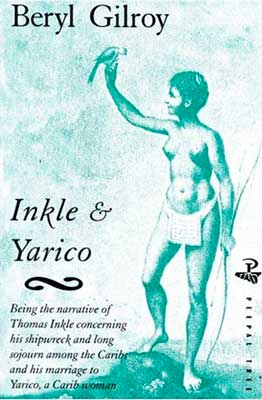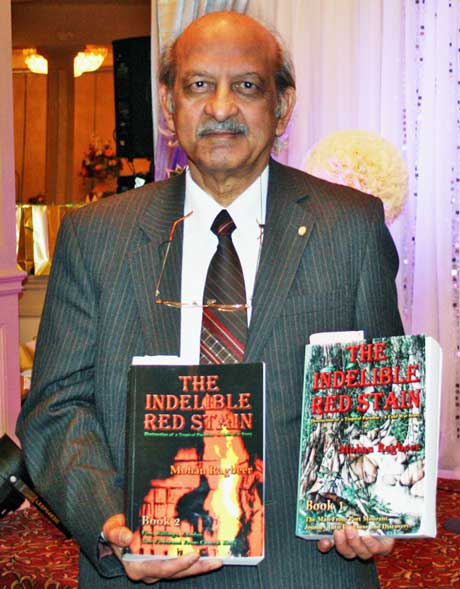Book Review

A review by Frank Birbalsingh
Inkle and Yarico, a novel by Guyanese Beryl Gilroy (1924-2001) is based on a story in Richard Ligon's A True and Exact History of the Island of Barbados (1657) which tells of an Englishman, Thomas Inkle who is shipwrecked on a small island - No Man's Land - while on his way to his family plantations in Barbados. Gilroy (née Answick) was trained as a teacher in Guyana, and migrated to England in 1951 where she did further studies, got married, and continued her teaching career in London. When she became Head-teacher in 1969, it was the first time a black person held such an appointment in England. Gilroy's writing career began with Black Teacher (1976), a record of her experience as a teacher in London. She afterwards wrote novels of which Frangipani House (1986) - about residents in a Guyanese retirement home - is the first, and Green Grass Tango (2001) the last. Gilroy is also the author of one volume of poems Echoes and Voices (1991).
In Inkle and Yarico, her seventh novel, Gilroy dramatises Ligon's story of Thomas Inkle through Inkle's own words. After his shipwreck, Inkle's crew is slaughtered by Caribs who inhabit the island, and he himself is rescued by Yarico, daughter of their chief Tomo. But after cohabiting with Yarico for seven years, and having relationships with two other women - Zeze 'my youthful delight', and Delvina 'my indiscretion' – Inkle accompanies Yarico on a vessel to Barbados where he abruptly sells Yarico to a merchant. Events in Ligon's story probably take place during the 17th or 18th century, but discussions in Inkle and Yarico about the abolition of slavery, and about contemporary activities of the famous abolitionist Thomas Clarkson, suggest that Gilroy's narrative unfolds in the early 1800s, shortly before slavery was abolished in 1834.
Debate about the abolition of slavery was as heated in the 1830s as the controversy between American capitalism and Russian communism which we witnessed less than a generation ago. This debate is what sustains much of the drama in the second half of Inkle and Yarico; it also justifies the author's advancement of the action of her novel into the early 1830s. On one side are plantation owners like Inkle, and on the other are Inkle's former fiancée Alice and her husband Dr. John Clarkson, nephew of the abolitionist Thomas Clarkson. Alice explains that she only got married after believing that her fiancé – Inkle – had died in the shipwreck. But she and her husband who is a physician as well as a plantation owner are avowed abolitionists who: "gather information attesting to the cruelties endured by the slaves," and send it to Members of Parliament in London to help in the parliamentary battle for abolition. One can see why abolition was a vexed question when both supporters and attackers could be found among plantation owners.
At first, Inkle claims to be neutral in the debate; but he is soon telling Alice: "We are a superior race. We need others lower than ourselves. Irish, Jews, slaves. In Barbados Jews are forbidden to employ Irish servants. Irish folk work only in their own fields." He is also very blunt in admitting the raw hatred of his fellow planters for abolitionists who could be seen as threatening Britain's rich income from her Caribbean colonies: "among them [Inkle's planter friends] were men whose raw hatred of those who sought to change their lucrative lives knew no bounds."
As narrator and chief character, Inkle takes centre stage in the novel, and much of Gilroy's success depends on the consistency and conviction of his portrait. His treatment not only of Yarico, but of two other sexual partners – Zeze and Delvina – is repugnant. While he is at pains to consider Alice's feelings by explaining that his association with Yarico only began when he failed to find her, he coldly justifies his sexual ill-treatment of Carib women by: "the gulf of civilisation that existed between us. We understood nothing in the same way: friendship, love kindness all meant different things to each if us." This is no doubt why Inkle can treat Yarico as mere merchandise and sell her without batting an eye. But somehow Inkle's justification of his racist attitudes seems excessive, especially when there is no anger or strong feeling that accompanies it. It is too matter-of-fact.
In explaining why he could not imagine fathering children by Yarico, Inkle again coldly confesses: "I simply could not imagine some creature like those around me being my son." In addition, one of his most cruel actions is confining the son of his most faithful slave in a cage, and hanging the boy when his father remonstrates. At the same time, Inkle makes an effort to understand his Carib hosts, sometimes described as black Caribs because they are mixed with Africans. Early on he describes Yarico as "an Eve in Eden," and later admits that: "The forest had a voice of its own...which could be understood by those who loved it." His confusion in despising and respecting the Caribs at the same time is perhaps the point Gilroy is making.
As a pioneering novelist Gilroy illuminates the role of slavery in Caribbean history. In addition to Inkle and Yarico, her earlier novel Stedman and Joanna: A Love in Bondage (1992) draws on the account of a British-Dutch soldier John Gabriel Stedman who describes his experience in Surinam in Narrative of a Five Years Expedition Against the Revolted Negroes of Surinam (1790). Gilroy is particularly illuminating in exploring the role of women in slavery. Her female characters – Yarico, Zeze, Delvina and Alice are far more sturdy, assertive and convincing than their male counterparts in Inkle and Yarico, and many times more memorable.

Dr Mohan Ragbeer introduced his long awaited twin volume book, "The Indelible Red Stain", based on Dr Cheddi Jagan's political posturing in British Guiana (now called Guyana) in its pre-independence years and its repercussions. The books, subtitled "The destruction of a tropical paradise – a Cold War story" sought to explain the exodus of so many Guyanese, in particular Indo-Guyanese from the land of their birth.
An enthusiastic crowd, braving the cold weather, showed up at the Bombay Palace Restaurant in Brampton last Saturday but the planned launch and autograph session was frustrated due to the printer's failure to meet their December 9th delivery schedule, and by launch time the volumes had not arrived. However, undaunted by the absence of the books, the two editors Ram Jagessar and Mary Ragbeer introduced them with the aid of handouts, praising the depth of content and quality of writing after which Dr Ragbeer passionately sought to explain pre-independence Guyana and the factors that led him to document his experience.
As someone who personally knew Dr Jagan and worked closely with him, Dr Ragbeer discussed what he described as the folly of Dr Cheddi Jagan's pursuit "of a communist political ideology at that time" despite being advised to move to a middle path by many of his most objective and trusted supporters and followers.
Dr Ragbeer, quoting the population figures of the country at that time, which stood at around 600,000 in 1961, noted that according to population growth rate for Guyana the population should have been about 1.5M by now yet it stands at about one half of that amount at present. He lays the blame squarely on the political path pursued by Dr Jagan. He said that Guyana at the time had both the human and natural resources to become one of the wealthiest countries of the world but fell by the wayside because of the political path pursued by its leaders. He cited the Ivory Coast, a country with many similarities to Guyana, and Singapore as two countries that have prospered by pursuing a moderate political and economic policy and lamented that Guyana did not follow suit. He pointed out that Errol Barrow, who led Barbados to independence, was as communist as Dr Jagan but soon realised that communism had no place in his country if it were to move forward.
Today the bulk of the population that escaped Guyana resides in Canada and the USA and they chose to come here despite the challenges and uncertainties of these colder climates and alien peoples. Many of them still maintain an interest in their home country's politics and these books would be of interest to them as to anyone who wishes to know the untold story of how purely blind political posturing destroyed a promising country.
A launch date would be announced in due course when the books arrive. For further information please contact Ken Singh at 905 673 5000.